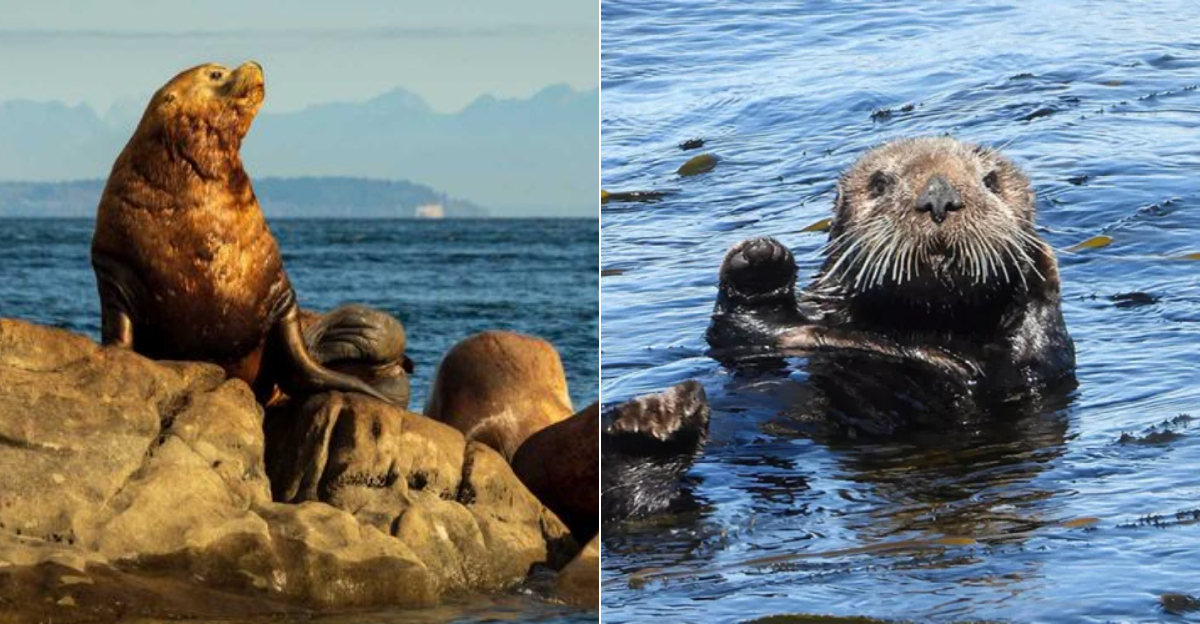The Northern California coastline offers some of the best wildlife viewing opportunities in the world.
I’ve spent countless mornings with my binoculars, watching these magnificent creatures breach, splash, and play in their natural habitat. From massive whales to playful otters, these waters host an incredible variety of marine mammals that leave both locals and visitors truly stunned.
These favorite ocean-dwelling neighbors definitely make our shoreline so special.
1. Harbor Seal: The Curious Coast Dweller
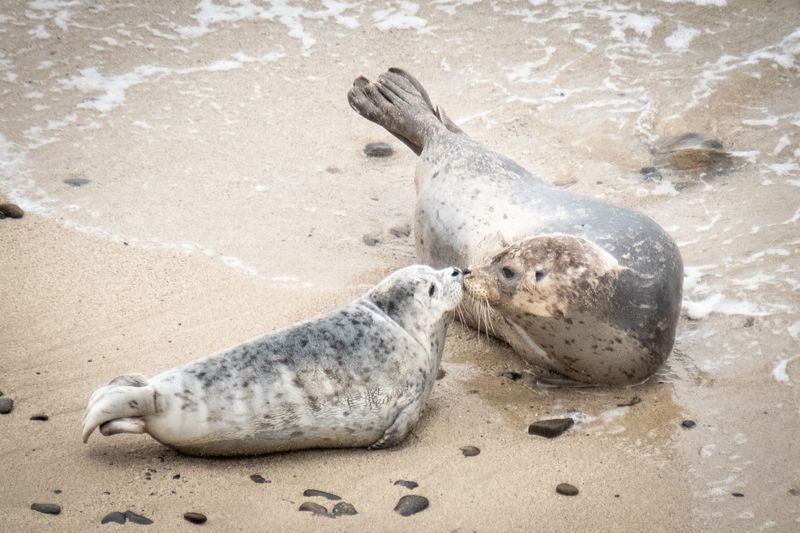
Spotted one of these adorable whiskered faces popping up beside my kayak last summer! Harbor seals are the puppies of the sea with their big soulful eyes and speckled coats.
Unlike their rowdier sea lion cousins, these quiet observers prefer to watch the world go by from rocky outcrops. They’re year-round residents along our foggy shores, often lounging in groups (called ‘pods’) during low tide.
Their bodies are perfectly round when dry but transform into sleek torpedoes underwater. Fun fact: Harbor seal pups can swim within hours of birth! I’ve watched mothers teaching their babies to dive near Bodega Bay—truly heart-melting moments that remind me why I love our coastal wilderness.
2. California Sea Lion: The Noisy Neighbor
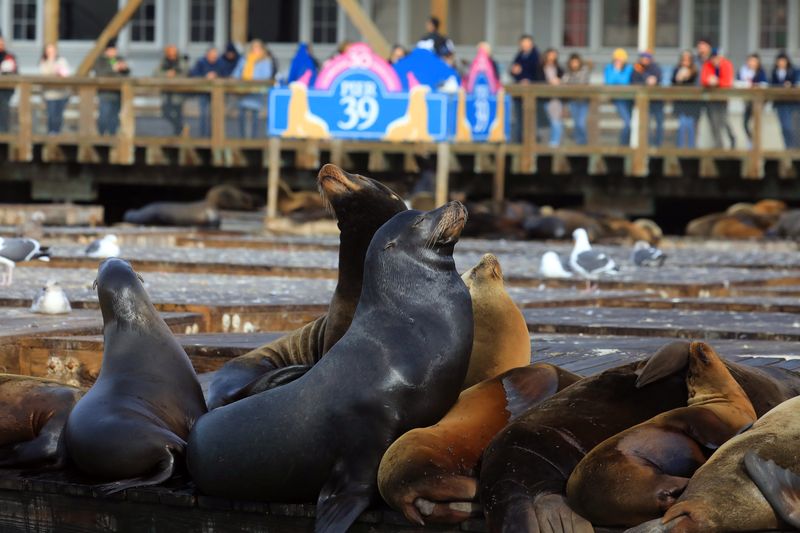
ARK! ARK! ARK! That distinctive barking has become the soundtrack of my coastal walks. California sea lions are the extroverts of our marine community—loud, social, and impossible to ignore.
Their golden-brown bodies crowd our piers and buoys, creating living pyramids of blubbery buddies. Males can weigh up to 800 pounds and sport a distinctive bump on their forehead called a sagittal crest.
Last year at Pier 39 in San Francisco, I witnessed a particularly theatrical male perform what looked like an impromptu synchronized swimming routine. These charismatic creatures aren’t just marine mammals—they’re natural entertainers!
3. Steller Sea Lion: The Majestic Giant
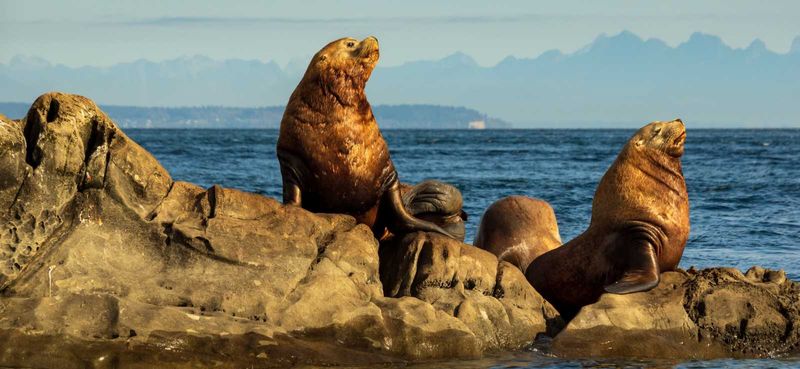
Holy mackerel! The first time I spotted a male Steller sea lion, I actually gasped out loud. These magnificent beasts make their California cousins look positively tiny by comparison.
Males can reach a whopping 2,500 pounds with a thick mane that gives them a lion-like appearance. Their deep roars echo across Northern California’s remote rocky outposts like Año Nuevo Island. Unlike sea lions, these giants prefer wilder habitats.
The raw power and primitive majesty of these endangered creatures left me speechless and reaching for my camera to capture their golden-bronze coats gleaming in the sun.
4. Northern Elephant Seal: The Beach Master
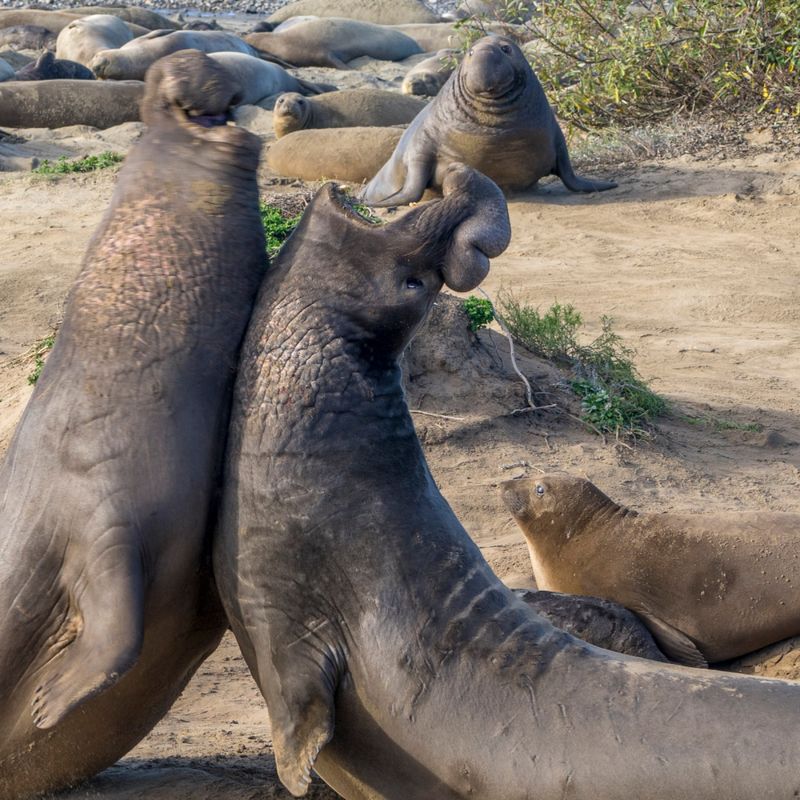
Talk about a glow-up! Male elephant seals transform from sleek swimmers to massive, trunk-nosed behemoths during breeding season.
These colossal creatures can reach 5,000 pounds, with males sporting that distinctive pendulous snout that gives them their name. The beaches literally shake when these titans clash, slamming their massive bodies together in slow-motion sumo matches.
What amazes me most is their incredible diving ability. These blubbery giants can plunge nearly a mile deep and stay underwater for up to two hours!
5. Northern Fur Seal: The Comeback Kid
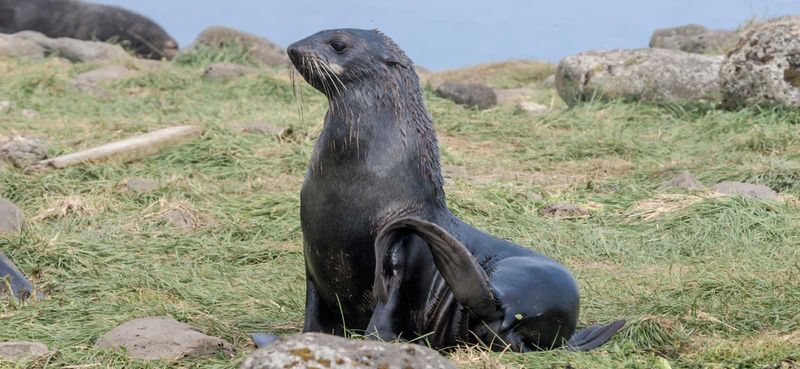
Velvety fur that would make a mink jealous! Northern fur seals sport some of the densest fur in the animal kingdom—nearly 300,000 hairs per square inch. This luxurious coat nearly led to their demise during the fur trade era.
I’ll never forget spotting my first fur seal from a whale watching boat near the Farallon Islands. Unlike other seals, they have visible external ears and longer front flippers that let them “walk” on land with surprising agility.
Once hunted to near extinction, these remarkable animals are slowly returning to their historical breeding grounds off Northern California. Their recovery story gives me hope for other struggling marine species.
6. Sea Otter: The Floating Comedian
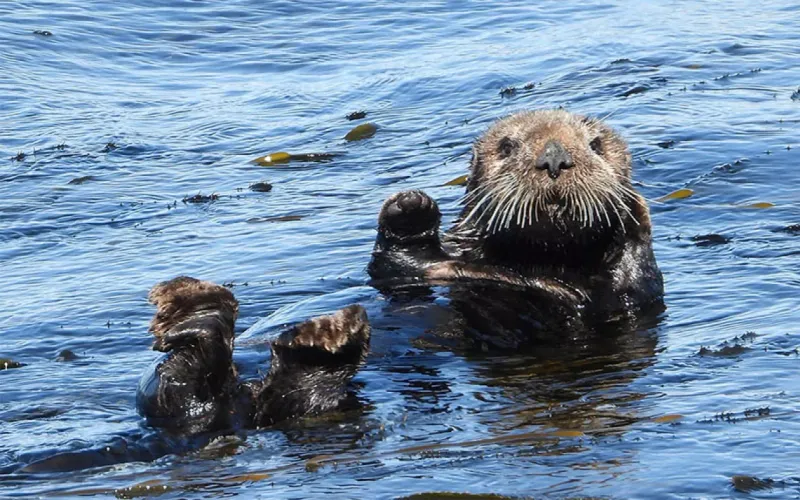
Cuteness overload! Sea otters floating on their backs while cracking shellfish on their tummies never fails to make me smile.
Without blubber, they rely on this incredible coat and a supercharged metabolism to survive in cold waters. Sea otters almost disappeared from California waters due to the fur trade, but conservation efforts have helped their numbers rebound.
Watching them use rocks as tools to crack open shells shows their remarkable intelligence. I’ve even seen them playfully steal each other’s food like mischievous children!
7. Gray Whale: The Epic Voyager
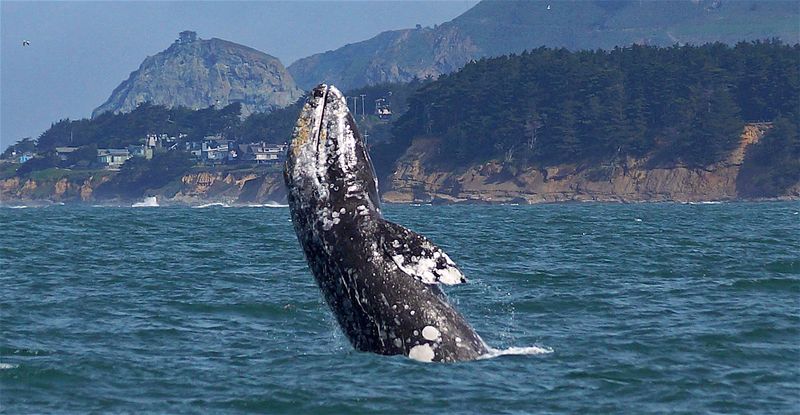
Barnacle-covered backs breaking the surface signal one of nature’s greatest migrations! Gray whales travel over 10,000 miles annually between Arctic feeding grounds and Mexican breeding lagoons.
hese ancient mariners were once called “devil fish” for fiercely defending their calves from whalers. Today, they’ve become ambassadors of the deep, often approaching boats with apparent curiosity.
Their mottled gray bodies and lack of dorsal fin make them instantly recognizable as they hug our coastline during migration.
8. Minke Whale: The Shy Speedster

Blink and you’ll miss them! Minke whales are the ninjas of the whale world—quick, elusive, and masters of the surprise appearance.
Though the smallest baleen whale in our waters, these 30-foot speedsters still pack an impressive punch when they suddenly surface beside your boat. Unlike their showier cousins, minkes rarely breach or show their flukes.
Their distinctive white bands on dark pectoral fins flash like secret signals underwater. What fascinates me most is their curious nature despite their shyness. They’ll often approach boats, then vanish for long periods. Their short, sharp blows are easily missed in choppy water.
9. Humpback Whale: The Ocean’s Acrobat
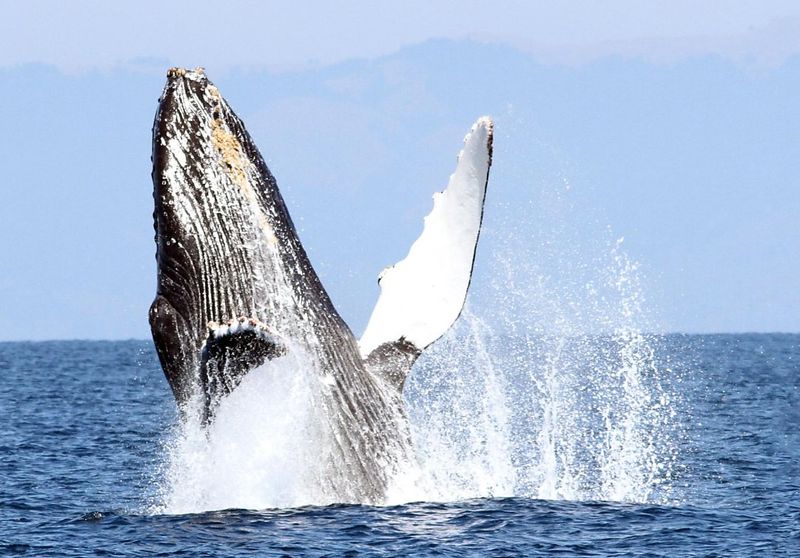
SPLASH! Nothing gets your heart racing like a 40-ton whale launching its entire body out of the water! Humpbacks have turned feeding into performance art along our coastline, with breaches, tail slaps, and bubble-net feeding that draw gasps from whale watchers.
Their massive pectoral fins give them incredible maneuverability. I’ve watched them roll sideways, waving these white-patched “wings” like underwater ballet dancers. Each humpback’s tail fluke bears unique patterns, like a fingerprint in black and white.
Though males primarily sing in breeding grounds, occasional vocalizations can be heard in our waters too. Their complex melodies seem to carry the mysteries of the deep within each note.
10. Blue Whale: The Living Legend
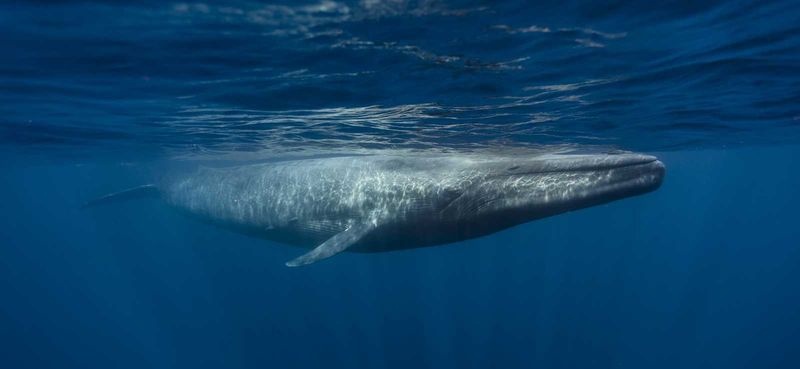
Goosebumps guaranteed! Spotting a blue whale—the largest creature ever to exist on Earth—feels like encountering a living legend.
Their heart-stopping size (up to 100 feet long) becomes apparent when their seemingly endless backs roll through the surface like living submarines. Summer brings these oceanic giants to our waters to feast on krill.
Most awe-inspiring is knowing each of these magnificent beings weighs more than 15 school buses and has a heart the size of a compact car. Their tongues alone weigh as much as an elephant!
11. Pacific White-Sided Dolphin: The Aerial Performer

Zipping through waves like aquatic rockets! Pacific white-sided dolphins transform our coastal waters into nature’s greatest circus. These black-and-white speedsters travel in pods of hundreds, turning ordinary boat trips into extraordinary spectacles.
Last summer, our fishing trip was hijacked by a super-pod of these acrobats. They raced alongside us, launching synchronized jumps that would make Olympic gymnasts jealous. Their distinctive two-tone coloration creates beautiful patterns as they corkscrew through clear water.
They ride bow waves, spin mid-air, and even surf in the wakes of larger whales!
12. Northern Right Whale Dolphin: The Sleek Speedster
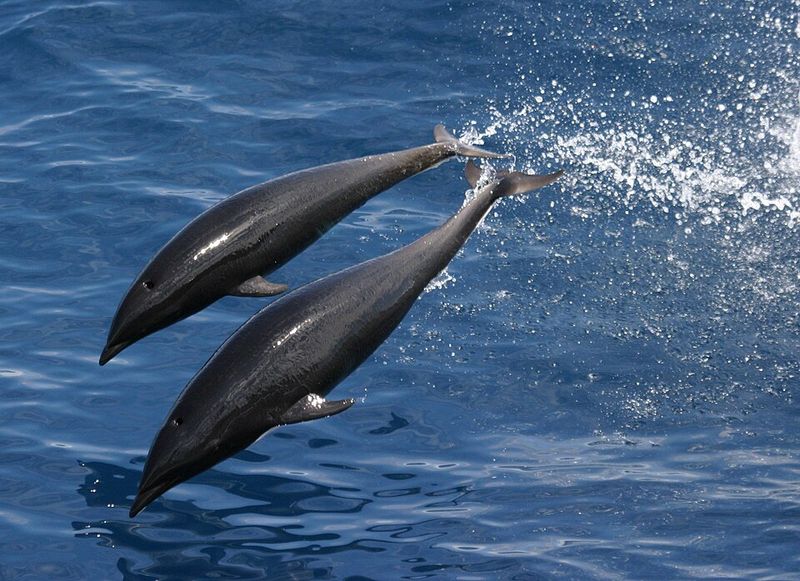
The first time I spotted Northern right whale dolphins, I thought my eyes were playing tricks! These glossy black torpedoes with white undersides streak through our waters like aquatic roadrunners, completely lacking the dorsal fin we associate with dolphins.
Their streamlined bodies allow them to reach impressive speeds, often traveling in mixed pods with other dolphin species.
Unlike their acrobatic cousins, these unique dolphins tend to make low, graceful leaps, briefly revealing their sleek bodies before slicing back into the waves. Their synchronous movements through the water create a hypnotic effect that kept my camera clicking non-stop until they disappeared into the blue depths.
13. Dall’s Porpoise: The Ocean’s Speedster
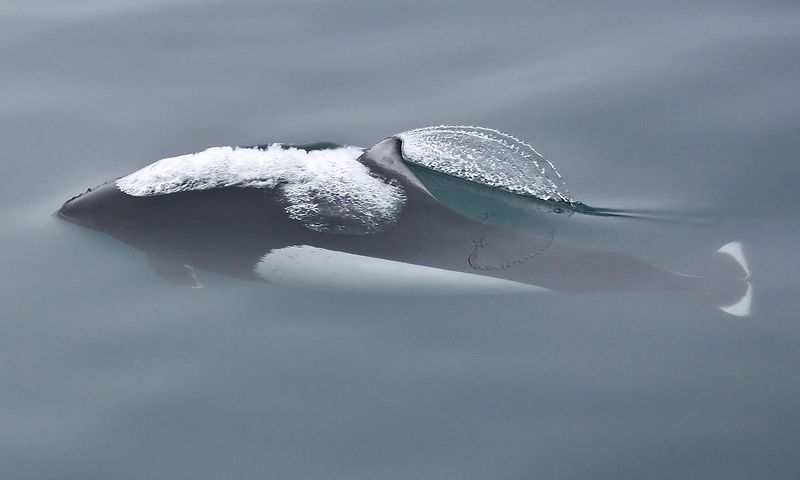
Rooster tails of spray announce these marine speed demons! Dall’s porpoises are the fastest of all small cetaceans, rocketing through our waters at up to 35 mph.
They created characteristic “rooster tails” of spray as they surfaced at high speed. Unlike dolphins, these chunky porpoises rarely leap clear of the water. Instead, they charge through the surface, creating those distinctive splashes.
Their energetic bow-riding and playful zigzagging around boats turns even seasick passengers into smiling wildlife enthusiasts!
